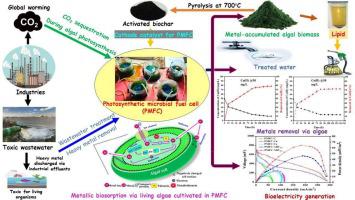当前位置:
X-MOL 学术
›
Bioresource Technol.
›
论文详情
Our official English website, www.x-mol.net, welcomes your feedback! (Note: you will need to create a separate account there.)
Heavy metals removal by algae and usage of activated metal-enriched biomass as cathode catalyst for improving performance of photosynthetic microbial fuel cell
Bioresource Technology ( IF 9.7 ) Pub Date : 2024-06-24 , DOI: 10.1016/j.biortech.2024.131038 Swati Das , Santosh Kumar , Arun Kumar Mehta , Makarand M. Ghangrekar
Bioresource Technology ( IF 9.7 ) Pub Date : 2024-06-24 , DOI: 10.1016/j.biortech.2024.131038 Swati Das , Santosh Kumar , Arun Kumar Mehta , Makarand M. Ghangrekar

|
Cytotoxic, malignant, and mutagenic pollutants like heavy metals have emerged as a serious global threat to the ecosystem. Additionally, the quantity of noxious metals in water bodies has increased due to expanding industrial activities and the application of incompetent wastewater treatment techniques. Owing to the benefits of eco-friendly phytoremediation, the utilization of algae in photosynthetic microbial fuel cell (PMFC) for removal of heavy metals has attracted increasing attention among researchers. Therefore, a successful fabrication and operation of a modular PMFC for simultaneous algal biomass production was exhibited, thus resulting in significant removal efficiency of Cu(II) (94 %) and Co(II) (88 %). Moreover, Co(II)-accumulated algal biochar after thermal activation was utilized as a cathode catalyst for the first time and attained 64.2 mW/m of power density through PMFC. Hence, this easily synthesised green cathode catalyst proved its ability to enhance the overall performance of PMFC by attaining higher power output while treating wastewater.
中文翻译:

藻类去除重金属以及使用活性富金属生物质作为阴极催化剂提高光合微生物燃料电池的性能
重金属等细胞毒性、恶性和致突变污染物已成为对生态系统的严重全球威胁。此外,由于工业活动的扩大和不合格废水处理技术的应用,水体中有毒金属的数量有所增加。由于生态友好的植物修复的优点,利用藻类在光合微生物燃料电池(PMFC)中去除重金属越来越受到研究人员的关注。因此,展示了用于同步藻类生物质生产的模块化 PMFC 的成功制造和运行,从而实现了 Cu(II) (94%) 和 Co(II) (88%) 的显着去除效率。此外,热活化后的Co(II)积累的藻类生物炭首次被用作阴极催化剂,并通过PMFC获得了64.2 mW/m的功率密度。因此,这种易于合成的绿色阴极催化剂证明了其能够在处理废水的同时获得更高的功率输出,从而提高 PMFC 的整体性能。
更新日期:2024-06-24
中文翻译:

藻类去除重金属以及使用活性富金属生物质作为阴极催化剂提高光合微生物燃料电池的性能
重金属等细胞毒性、恶性和致突变污染物已成为对生态系统的严重全球威胁。此外,由于工业活动的扩大和不合格废水处理技术的应用,水体中有毒金属的数量有所增加。由于生态友好的植物修复的优点,利用藻类在光合微生物燃料电池(PMFC)中去除重金属越来越受到研究人员的关注。因此,展示了用于同步藻类生物质生产的模块化 PMFC 的成功制造和运行,从而实现了 Cu(II) (94%) 和 Co(II) (88%) 的显着去除效率。此外,热活化后的Co(II)积累的藻类生物炭首次被用作阴极催化剂,并通过PMFC获得了64.2 mW/m的功率密度。因此,这种易于合成的绿色阴极催化剂证明了其能够在处理废水的同时获得更高的功率输出,从而提高 PMFC 的整体性能。






































 京公网安备 11010802027423号
京公网安备 11010802027423号